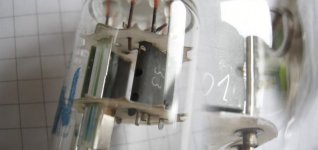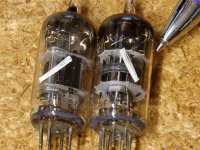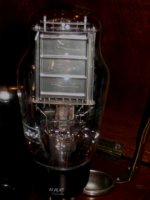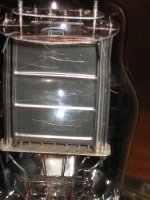Ok i cant be the only one that has noticed those (what looks to be intentional) scratches on some tube plates. I've always wondered about them. Usual i see just an X scratched on the plate, usually on black plates. But today i saw a perfect little check mark on a submini and now i'm thinking some bored factory workers did this just to **** with my head 50 years later. j/k But whats the deal with these plate markings? Anyone know? They were intentional right?
I think you will find alot of this is human quality control on bits that are hand assembled. Considering the manufacture of a tube implies over 400 operations,really I'm suprised there aren't more scratches.
A blended anode photo of an early ECC82 and a Tesla KT88. Quite normal.
A blended anode photo of an early ECC82 and a Tesla KT88. Quite normal.
Attachments
i'm thinking some bored factory workers did this just to **** with my head 50 years later.
Sounds like they were successful too! I spent a lot of time in a large factory 30+ years ago. Think about what you would do if your life was devoted to stuffing the same part into the same assembly 8 to 12 hours a day for 25 years. Often without knowledge as to what you were building, or why it had to be built that way.
I saw lots of "creative expression" by line workers. One example involved marijuana leaves drawn into the solder plating on product destined for the BNDD (now the DEA).
As stated often the marks were QC related. In my case if a subassembly didn't look or fit right the assembler put it aside. A QC inspector would decide if it was acceptable for use, and then stamp it with their inspectors number.
I can understand marks on the plates. I can not explain spare parts however. Look at these two tubes. They both work and are at least 50 years old and were pulled from working military spare equipment. Each contains an extra heater. It is just hanging out, loose waiting to spark something out internally. Was the assembly operator feeling generous, thinking someone would actually need a spare heater in case the original burnt out? Nah, " **** with my head 50 years later" sounds more likely😉
Attachments
I saw lots of "creative expression" by line workers. One example involved marijuana leaves drawn into the solder plating on product destined for the BNDD (now the DEA).
I can understand marks on the plates. I can not explain spare parts however. Look at these two tubes. They both work and are at least 50 years old and were pulled from working military spare equipment. Each contains an extra heater. It is just hanging out, loose waiting to spark something out internally. Was the assembly operator feeling generous, thinking someone would actually need a spare heater in case the original burnt out? Nah, " **** with my head 50 years later" sounds more likely😉
so funny! haha
I bet it was a typo or ambiguity in the assembly procedure and some worker was feeling a little more ornery than usual that day.
I totally understand the assembly line worker mindset. I worked on "the line" as an intern for a couple of summers building cellular LPA subassemblies. Tedious work placing dozens of tiny SMT parts with tweezers in solder paste on these crazy ceramic substrates over and over. Most of the people I worked with did it day in and day out and didn't seem interested in finding anything better to do. Years later those factories slowly shut down. I ran into a few of those guys after I was hired as an engineer. It was a little bizarre.
I totally understand the assembly line worker mindset. I worked on "the line" as an intern for a couple of summers building cellular LPA subassemblies. Tedious work placing dozens of tiny SMT parts with tweezers in solder paste on these crazy ceramic substrates over and over. Most of the people I worked with did it day in and day out and didn't seem interested in finding anything better to do. Years later those factories slowly shut down. I ran into a few of those guys after I was hired as an engineer. It was a little bizarre.
I worked on "the line" as an intern for a couple of summers building cellular LPA subassemblies.
I started as a line technician in 1973 analyzing the boards that came off of the line and trying to figure out what creative assembly techniques had been used. The plant had only been here for a year, so that was the maximum experience level. Many line workers had only been there for a few weeks. Same for factory techs. SMD wasn't even a dream yet, so the workers were stuffing very small leaded parts into small through hole boards. I worked in that factory directly for 11 years, and spent a lot of time there after I joined product development since I was familiar with factory flow. I watched product design and assembly evolve into the automated SMD assemblers of today, until it all went away. There are still about 10 people around that remember the "old way".
That experience was an education in PC board design that can not be learned in school.
I bet it was a typo or ambiguity in the assembly procedure and some worker was feeling a little more ornery than usual that day.
I totally understand the assembly line worker mindset. I worked on "the line" as an intern for a couple of summers building cellular LPA subassemblies. Tedious work placing dozens of tiny SMT parts with tweezers in solder paste on these crazy ceramic substrates over and over. Most of the people I worked with did it day in and day out and didn't seem interested in finding anything better to do. Years later those factories slowly shut down. I ran into a few of those guys after I was hired as an engineer. It was a little bizarre.
I did some electronic assembly work long ago in order to be able to pay the bills after getting laid off. The same observations would apply to my experience as well.. I would probably substitute the word "awkward' for "bizarre" in my experience.
I've gotten a tube or two with "spare parts" as well. One at least with a "spare" filament as George has shown, and another with a spare getter assembly.. I have a very vague recollection of getting one or two with odder items contained within..
Last edited:
That experience was an education in PC board design that can not be learned in school.
I can see why it would be. An education that no one in this country will ever be able to experience again, sadly.
I interned at a small company before that one, building high resolution computer monitor test equipment. Giant boat anchors with a 286 running the UI on a miniature monochrome monitor. The next summer they had me stuffing boards...full length ISA cards for convergence probe cameras with some tricky "3D" analog sections that were sensitive to how they were done. I did a few at first because their contractor couldn't build them fast enough. They let her go shortly after and had me do them from then on. I think I was 16 at the time and didn't really realize what had happened until a few years later, LOL.
I think I was 16 at the time
I got my first job when I was 16. My friends were pumping gas (it was 1968) or flipping burgers. I was......fixing tube (and SS) stuff. Things have changed, but things haven't changed.
George:
LOL! I had the same experience back around '73 and later the entire time I was in college and grad school.
The up side was complete flex-time (so I could attend classes) and I was paid on a piece-work basis; 40% of the labor charge. While my friends were pumping gas or flipping burgers for $3.00 an hour I was averging $25.00 an hour.
The down side was trying to get a job that paid as well with a ** and an MBA after I graduated. The ultra-down side was that when I did find that job, it was 9-5 EVERY DAY, day after day.
I just kept telling myself that the education would pay off in the long run.
I'm still telling myself the same thing today...............
LOL! I had the same experience back around '73 and later the entire time I was in college and grad school.
The up side was complete flex-time (so I could attend classes) and I was paid on a piece-work basis; 40% of the labor charge. While my friends were pumping gas or flipping burgers for $3.00 an hour I was averging $25.00 an hour.
The down side was trying to get a job that paid as well with a ** and an MBA after I graduated. The ultra-down side was that when I did find that job, it was 9-5 EVERY DAY, day after day.
I just kept telling myself that the education would pay off in the long run.
I'm still telling myself the same thing today...............
I got my first job when I was 16. My friends were pumping gas (it was 1968) or flipping burgers. I was......fixing tube (and SS) stuff. Things have changed, but things haven't changed.
I have a tube here somewhere if i find it ill take a picture. but the model number is on the plate
- Status
- Not open for further replies.
- Home
- Amplifiers
- Tubes / Valves
- Ever notice those scratches on some plates??



